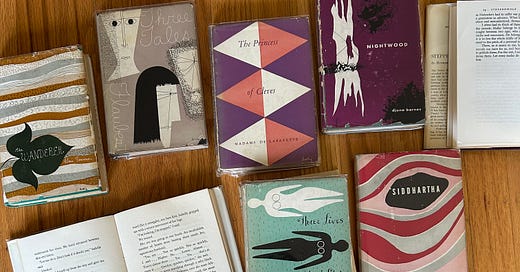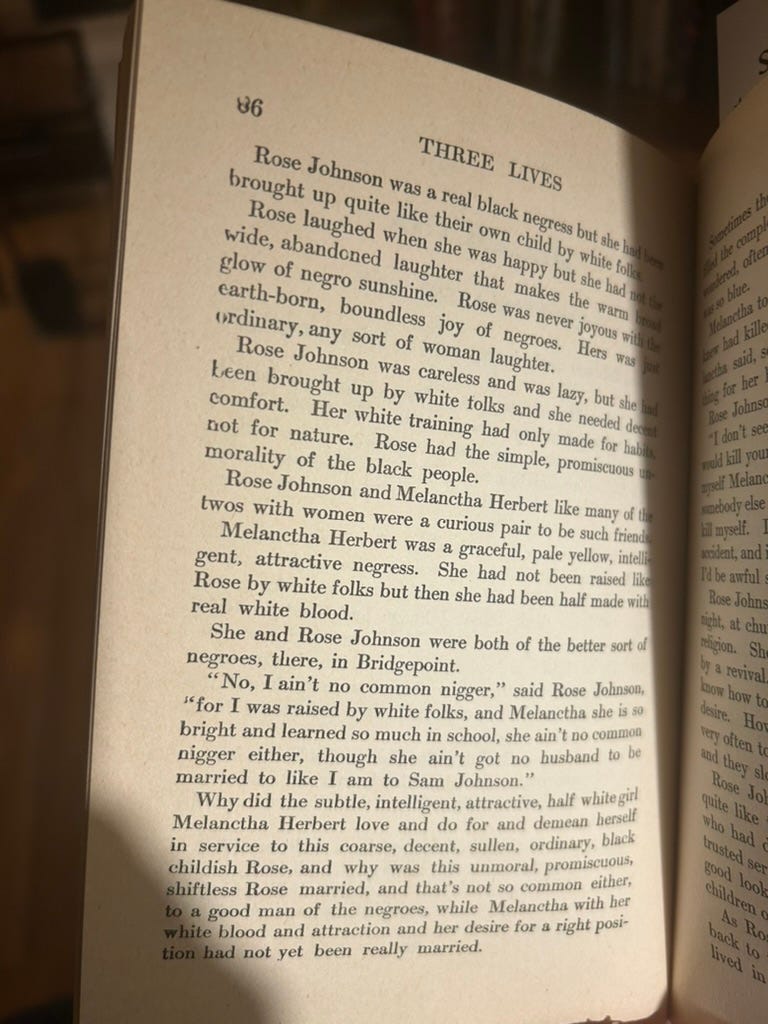Three Women, by Gertrude Stein
For the life of me, I cannot understand why Gertrude Stein is such a respected author. The influence Stein had on Hemingway is clear; the simplicity of her sentences are echoed in his1. Perhaps if I had been born before 1900, this would have been refreshing and innovative. In a few sections, after learning the full story of a character, the earlier sentences at the beginning of a story appearing again near the end are imbued with new meaning. Too often, when the same sentence or phrase appear mere pages apart, it feels unnecessary and static. This is especially in relationship to the sentence structure, which prime the reader for brevity rather than expansiveness. The lack of interiority of the characters, the description of scene and setting as splashes of color attempted to capture some of the new Cubist leanings and block-like simplicity of her artist-friends (Cezanne, Picasso), but what comes across as simply on the surface yet complexity underneath in visual art does not necessarily work in the same way in the literary arts.
Three Women (1909) is Stein’s first book. It’s a set of three stories, about three women. The first and the last, about two white German-American white women, are not what this book is known for. The first one, about Good Anna is vaguely sapphic, as Anna’s only romance is with another woman. Anna also has a very close friendship with another woman.
It’s the second story that makes the bulk of the book. In the foreword to my edition, Carl van Vechten2 wrote that this story, Melanctha, was the “most original and compelling” of the three. I concur. He also “[it] is perhaps the first American story in which a [Black person] is regarded as a human being not as an object for condescending compassion or derision”. That I do not concur with.
Melanctha is described as the offspring of a “yellow” (mixed race/light skinned mother) and a dark skinned father. Her mother is passive, her father controlling and at times abusive. Despite her intelligence and her emotional depth, Melanctha’s childhood lack of love thwart her potential. She’s a compelling character, and one you’ll root for. To escape her home life, she begins to wander. She makes a friend of an educated woman who has had lovers in her life (were these two women lovers? potentially, it’s never made clear). Sexual affairs are implied. Her parents pass, she meets a young doctor. They have many long, long, long conversations. He is drawn to her, falling in love, and then repulsed. The cycle repeats over and over; echoing the hot then cold pattern too many of us have experience with. Throughout, there’s a forecasting of the end of this affair, as the story begins with Melanctha older and alone. Throughout, Stein signals the sadness of the ending, the unfairness of the life of someone with promise.
The Racism
Is it racism? For Stein to write about and further, to create complex Black characters in 1909 would have been revolutionary. In 2025, we have a plethora of writings about Black characters and by Black writers (for examples, read this essay on the history of Black lesbian writings), so our view is different. Through the modern lens, Stein’s work read racist, because there’s certainly colorism and an outright agenda to associate white blood (genetics) with goodness. Melanctha, who inherits her mother’s pale “yellow” skin (in this era, lighter-skinned or mixed Black folks were described as having “yellow” skin) is good-at-heart, and intelligent both emotionally and in other ways. Darker skin folks, such as Melanctha’s friend Rose, or her father, are not good, nor smart. Further, Rose was raised by white folks, and yet, her Blackness genetic inheritance still corrupts. I’ve shared the passage where Stein makes this explicit in the photo below, though it’s implicit throughout the rest of Melanctha’s story.
Gertrude Stein moved to Paris, and lived with her lover, Alice B. Toklas. The two women lived as if in a heterosexual marriage. They were friends or acquaintances with the other Paris-based American and English lesbians, such as Radclyffe Hall, Natalie Barney, and Romaine Brooks. I vaguely remember reading that Natalie Barney and Romaine Brooks were not in agreement on their lifestyle - that is, the recreation of the bourgeois ideal of a couple, and sometimes poked gentle fun at it. I also vaguely wonder if the conformity to those ideals of Stein’s era meant she conformed to other ideals, such as the idea of associating “goodness” and intelligence with whiteness. An argument I see a lot is that we should accept that authors pre-1960s (or so) are more racist. I’d argue if you read outside of the mainstream and standard Western canon of classics, you’ll find that’s…not true. The colorism or racism in Stein’s work wasn’t present in works of her lesbian contemporaries. Example include Natalie Barney (admittedly, her works did not include people of color), Rene Vivien, who did include people of color in non-racist ways, and thirty years later, Annemarie Schwarzenbach, whose travelogue was also fairly accepting of the non-white people she met while traveling. Yes, all were lesbians, but the latter authors led non-conventional, non-conformist, eg, non-monogamy, “living life as art”, traveling widely, in Vivien’s case, a deep interest in Asian cultures and religions.
The conformity to bourgeois standards or not is a split that still exists amongst queer communities today, with folks on both sides of the divide questioning the other. The association between race, whiteness, and conformity also exists today. The tradwife and returning to quote-unquote traditional values movements both imply that heteronormative lifestyles and whiteness are both traditional. For a queer person such as Stein, this could look like conforming to other socially acceptable values, such as viewing whiteness as superior, with queerness the single exception. Some folks presume that LGBTQIA+ are necessarily more liberal/progressive. The line of thinking would be something like: since the liberals and progressive movements are more supportive of those communities, the queers support those politics. Yet, we have some famous examples of lesbian and gay thought leaders (including at least two very famous Substackers3) and gay tech leaders who are otherwise conservative and/or libertarian. The value system still holds: those with more conservative views and lifestyles are still less accepting of people of color, over a hundred years later.
If you read this…
This article focuses on racism, colorism, and antiblack or the lack thereof from white lesbian writers toward Black folks. If you’re interested in the writing and perspectives of Black lesbians, here’s a piece about that.
Pretty, literary things
If you read my notes (here), you might notice that I share a lot of quotes, works of art, and small, beautiful things. I thought it might be nice to share them here. If you like this idea, let me know and I’ll add more in future posts.
The books in my cover photo are part of my collection (I forgot Kafka’s Amerika and Paul Bowles’ The Sheltering Sky). They were designed by Alvin Lustig for New Directions. You can read about the collaboration here. I think the graphic design is lovely, but the smaller size of the books is also very comfortable to hold, or carry in a pocket. If you’re interested in them: hunt around. Some sellers will charge hundreds, others around $20 (US).
This Sarah McNally interview. It’s so good. So much nuance. The little ways the interviewer checks her little pretensions and idiosyncrasies, but her charm and intelligence come across anyway. This is how a review, interview…the balance, the honesty…should be written.
This Tamara De Lempicka exhibit in San Francisco closes in two days. She’s a queer artist, and an amazing one with a fascinating life. It closes in two days, so run, run if you haven’t already been.
Another Substack!
Since I write about my advocacy/anti-#metoo increasingly more here, I thought I’d start a separate newsletter (substack) for that. This is my second attempt at this; my first attempt failed because I couldn’t find “my voice”. Writing here is helping me hone on that, so…here this goes.
Thus far, they are a bit more on the personal side, but in the future, I’ll be writing about policy and educational-and-think-pieces through the lens of current news stories about misconduct (think Giséle Pelicot, Neil Gaiman, Blake Lively, and less famous people too).
If you are here, I, perhaps arrogantly, presume you appreciate my writing. So if you care about stopping sexual misconduct, a subscription would be appreciated. I’ve created a few posts there already. Here it is.
I read Hemingway in high school and one college class, and never felt compelled to re-read his works again. This isn’t a style I particularly appreciate, your mileage may vary.
Carl van Vechten was an interesting person as well. He was interested in Black culture, and his claim to fame was a book with a title far too offensive and controversial for me to repeat here. He was Gertrude Stein’s executor. Romaine Brooks also painted him - note that she painted several faces loomed in the shadows behind him.
If you’ve read through a few of my essays, you’ll notice I never name the current US president, or other figures that - give me the ick. This is because I can’t bring myself to speak their names.






To be honest I haven't read Stein, but this definitely does not make me want to!